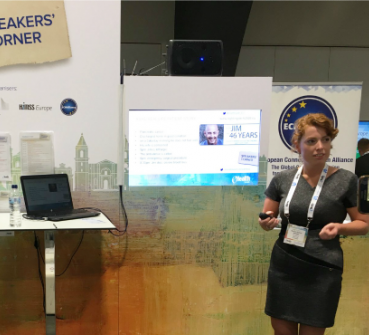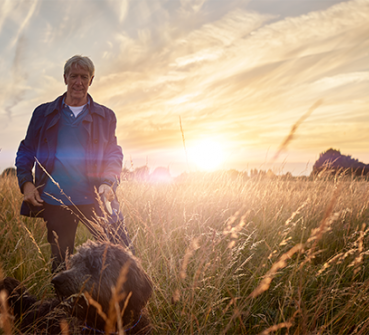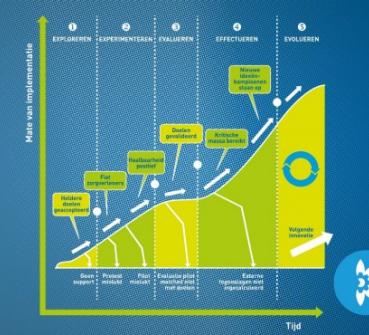Day 3 in Silicon Valley: An exciting day with doctors themselves
Whereas we spent Day 1 focusing on innovation centers and policymakers, on Day 2 we headed into the Valley to focus on technology. Day 3 was characterized by conversations with doctors themselves at the bustling (and sunny) Stanford Hospital. We finished the day with a visit to the biggest law firm in Silicon Valley to learn about doing business in the US…
Can I help you sir?
Aside from the beautiful campus with its manicured lawns, flowers and attractive buildings, the first thing we noticed as we arrived at Stanford was the huge focus on patients and hospitality. As we drove into the parking garage, we were patiently directed where to go. Once we arrived upstairs, there was a man (wearing a surgical mask!) waiting to make sure we arrived at the right destination, using a special tram. There were even heat lamps and wheelchairs in the waiting area for the tram. As you arrive at Stanford Hospital, you really feel like a valued customer and everything is service-oriented to provide you with best possible support.
Geriatrics: Blended HomeCare is right on the money
Our first appointments were with several geriatricians who are active in supporting senior citizens. It soon became clear from the stories they told us that there is a great desire in the United States to enable senior citizens to remain independent and stay in their own homes, but that it is incredibly difficult to achieve. "It soon became clear that there is a great desire to enable senior citizens to remain independent and stay in their own homes" On the one hand, the cities here are very senior-unfriendly. There is not much social cohesion with the people around you, so loneliness is a big problem.
The second challenge for many senior citizens is mobility. To get to a hospital or visit your doctor you often have to drive an hour or more, which is not possible for many senior citizens. In short, the doctors we spoke to said our Blended HomeCare with cContact and the CompanionApp as modern tools to remain independent is right on the money because they arrange care remotely. This reinforces the social community of the senior citizens.
Let's do it. A pilot with 'the Dutch innovative way of care'
Following the enthusiastic response from geriatrics, we took a closer look at the possibilities of setting up a pilot project together. An important challenge in that respect is the fact that, although we are in the middle of the world's center of technological innovation, many senior citizens there have little or no access to the internet. Many senior citizens don't have smartphones, which seems strange to me considering they live a stone's throw from Apple's and Google's headquarters, but something we will have to take into account.
Nevertheless, introducing technology to senior citizens in a simple matter would be an interesting process capability. In California, once you are discharged from hospital, you are entitled to spend 100 days in a short-term rehabilitation center before returning home. The doctor can then prescribe six days of home care for activities of daily living (ADLs), which can be extended by another six days and subsequently by four weeks.
We agreed to explore this option in more detail and, if we find the right way of contributing to a pilot, to demonstrate here how effective Blended HomeCare is in improving quality of live and in preventing readmissions or visits to the emergency room following a hospital admission. I am excited about the possibility of collaborating and doing research with Stanford in this area.
Data is the new dollar
From geriatrics, we moved to anesthesiology where people are involved in monitoring. Interestingly, like Kaiser Permanente, Stanford has also set up a whole innovation process to streamline all technology, startups and other promising developments. Although doctors do feature in that process, they are not involved until a later stage because the technology has to be fully evaluated first. As I commented in my previous blog, the difference in privacy legislation between the US and Europe soon became clear. Here, data is the new dollar, because the information you make available as a patient (through monitoring technology as well as inclusion in your patient records) becomes the property of the software/technology providers who store and process it.
That in itself has become a business model, with suppliers wanting to do smart things with the data to provide the best possible services to doctors. The advantage is that patient data can be readily converted into information that is relevant to the doctors. The disadvantage is that data itself is a revenue model, making interoperability between systems impossible.
Bring Your Own Device
Because data is such an important subject, with security playing a crucial role, Stanford has found a very interesting way of facilitating Bring Your Own Device. Doctors bring along their own devices instead of obtaining them through the hospital. The hospital has a separate department where you can take your device to have it encrypted and provided with security software. It is up to you to decide how many and what kinds of devices, such as a laptop, smartphone or tablet, you wish to use, as long as you have them made suitable by the encryption police. Working in this way with everyone using their own equipment is smart, efficient and also cost effective in my opinion.
Stanford has a policy of encouraging doctors to be involved in numerous other activities besides practicing medicine. One of the doctors we talked to, an anesthesiologist, is also an entrepreneur in addition to her job as doctor and takes all kinds of courses in business at Stanford Business School (in her spare time?). She was very enthusiastic about how we are trying to set up monitoring in the Netherlands, and wanted to exchange research experiences with our PhD candidate to determine whether it would be useful to link things together. In particular, she mentioned the realization of care pathways from hospital to home care as something they currently apply with monitoring, which is working very well (a home visit when a patient is sent home with monitoring). Whereas they have a lot of great technologies that could be interesting for us, this integrated care approach is an area in which can share our knowledge with them.
Desire to achieve
As we walked across campus to our next appointment, I imagined her to be a very busy person, so I wondered whether it might take a while for the things we talked about to be followed up. But, while I was thinking, I heard a 'ping', and even though it had only been a half hour since the appointment, there was a follow up to each action in my mailbox. Bizarre. The energy on the Stanford campus is tangible. There is a desire to achieve that you can sense everywhere (and which is fed by a buzz, the sun, and the beautiful surroundings).
Virtual Reality: my own me as an 80-year-old avatar
We concluded our day at Stanford with a visit to a knowledge institute that focuses completely on issued related to the fact that people are living much longer. "Instead of worrying about the fact that our life expectancy is increasing so dramatically, with all of the associated consequences, they take action" This characterizes the mentality of the people at Stanford: instead of worrying about the fact that our life expectancy is increasing so dramatically, with all of the associated consequences, they take action. They establish a knowledge institute, surround themselves with businesses, and think about solutions to this issue. They have identified the themes mind, mobility and financial security as determining factors in being able to grow old happily and healthily, an interesting combination of both the softer and the more physiological elements involved in aging.
A great example is the way in which they raise the subject of aging in their special Oculus Rift Virtual Reality Lab. An avatar is created of a particular person, but many years older than he or she is today. By then talking, walking and interacting with the older versions of themselves in a virtual world, people are confronted with the challenges they face as they grow older. We explored a number of possibilities of exchanging knowledge and research support in pilots, because the theme of independent living is the center's priority.
The value of our consulate
Our last appointment of the day, at the law firm, was a great surprise. In view of the length of this blog, I will save that experience for tomorrow. I finish the evening with a sense of respect for the people from our Consulate and the Healthcare Innovation Transfer (HIT_USA) program. The way they have been able to find the right people here to offer us curious businesspeople a glimpse into the world of healthcare and technology is very impressive. The fact that the Netherlands has such an international infrastructure with such passionate people is unique.
Tomorrow will be our last day already. I will write about the differences between doing business in the United States and the Netherlands, a perfect example of the American Dream, and I will share my experiences with regard to our meetings on Day 4 with family doctors, UCSF Medical Center and a very special health tech company.
This blog was previously published on Skipr.nl.


